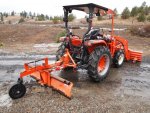... A 3 point hitch has no downward force so all the grading comes from the weight of the implement.....
There is resultant downforce generated by the blade as it "bites" nto material being cut.
These small tractors are able to move quite a bit of dirt with a properly used box scraper.
An overview:
first angle up the rear of the box and drop rippers
Next pass raise rippers all the way and keep box set with the rear up
Move forward and watch as the blade cuts down into the scarified material from 2 to 4" deep. Keep the 3 pt control lever pressed down until you reach the depth you want, then release it while the tractor is moving forward.
Continue through your "cut" and raise the box by "bumping" the 3 pt control to the lift position in stages until the material is diposited where it's needed.
Finally with the box set as it is (rear up) set the box on grade (that is at acceptable height) and back over the deposited material. The back blade will "strike off" highs and lows and the fore blade will finish off the surface.
Repeated passes will leave a smooth finish. Alternately one can adjust the top centerlink to lower the back of the box (to be lower than the front of the box and do the final grading by driving the tractor forward, HOWEVER, reverse from a known "good" piece of drive or road will keep the tractor (and blade) positioned to keep the desired grade.
If cross slope or crown is desired, set the angle by adjusting the lower lift arm.
I believe the rakes and back blade will shape a road and get rid of ruts, but the tractor is always running on uneven ground so the implement follows the tractor.
I'd like to see the rakes and back blade in action next to a box scraper (all run by knowledgeable operators). I feel (and am biased) that a box scraper would do the work faster and better.


